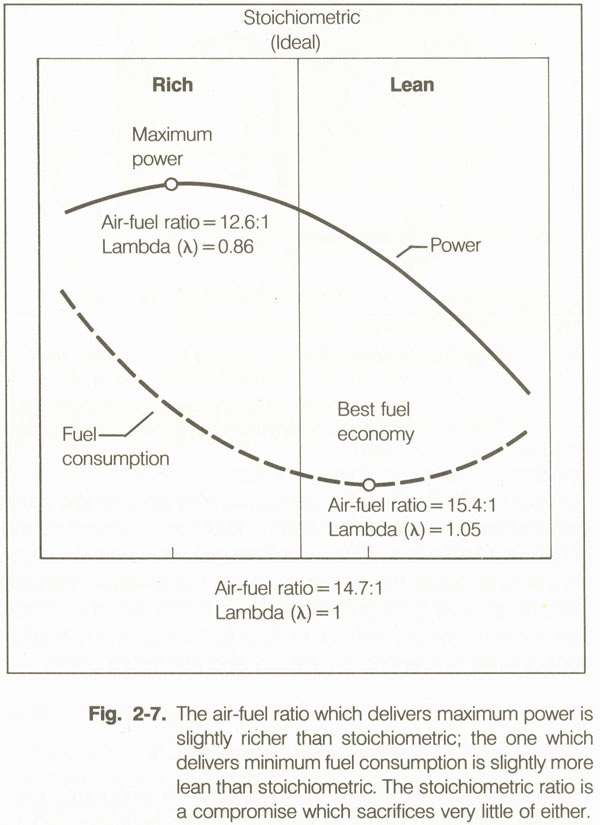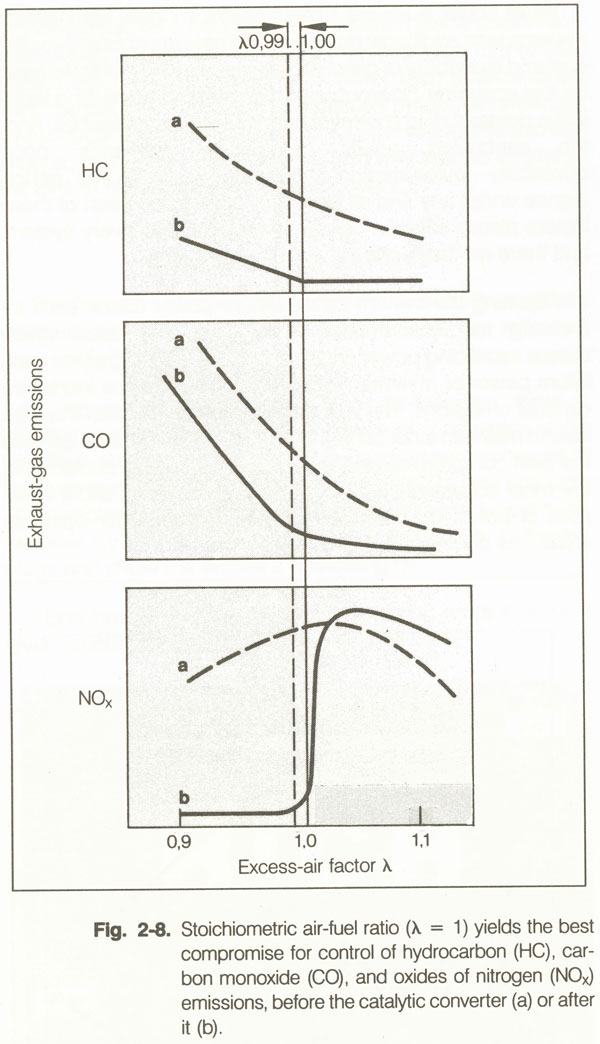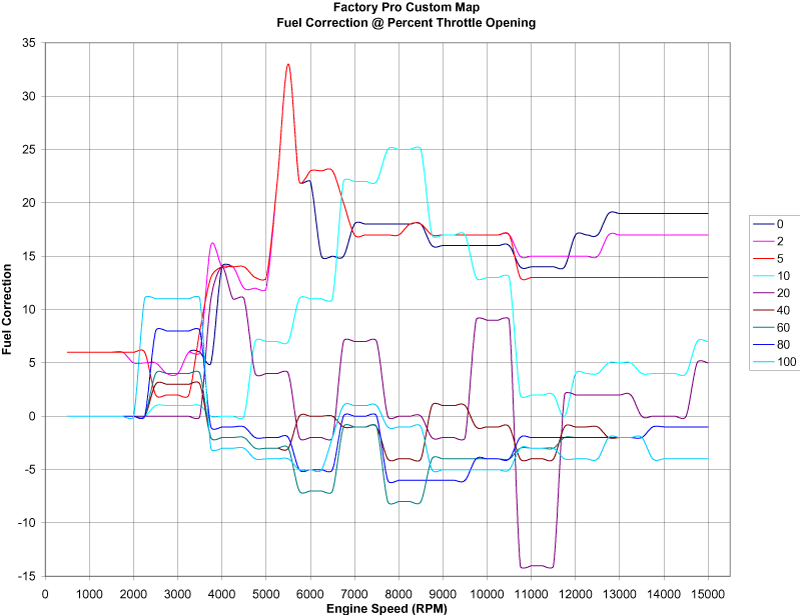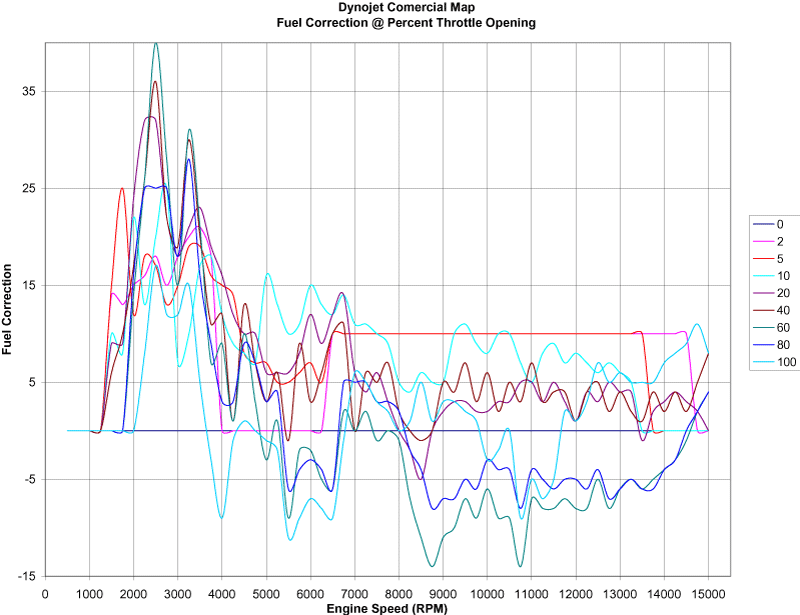
Power Commander & Custom Fuel Injection Map:
People that know nothing about tuning a bike will tell you that you only need to rejet or remap if you change exhaust pipes or make serious mod's. That is flat out wrong. All stock bikes need to be re-jetted or mapped. Bikes are designed with fuel systems that are compromised so that they can pass noise, emissions, and economy standards around the world. This, not to mention all of the different gasoline formulas available. Performance is usually the last consideration of the factory. Performance is my first consideration.
The following diagrams are from the book; Bosch Fuel Injection & Engine Management (Probst, 1991). They clearly show that any manufacturer is going to build a system that provides a lean mixture for fuel economy, or just slightly rich for minumum emissions, but far from the rich mixture neccessary for maximum power. Exhaust, intake, and other power enhancing modifications usually contribute to an even leaner mixture. The system must be corrected.
Usually, on high performance machines the lean conditions programed into the EMS are most pronounced a between 0 and 20 percent throttle opening and in lower rpm's. Goverment test procedures usually point to where the mixture will get leanest. Since the tests are rarely conducted at WOT and near redline, the system is probably running best in that range.


Installing the Power Commander
HERE is what Dynojet says about needing a powercomander.
Not much to say about this one. It installs very easy. 4 bypass connectors at each of the lower injectors and one bypass connector at the throttle position sensor, then a simple ground to the battery. I installed the map for completely stock bikes (M117-001). It is very important to calibrate the throttle position sensor to the power commander when installing. 1% error could make all the difference.
Once the Power Commander was installed, the bike idled better, ran smoother, had very crisp throttle response, and had a much smoother power curve. It really is worth the money.
The custom map is next. The standard maps that Dynojet and other manufacturers provide are created using what ever bike happed to be available at the time, in whatever state of tune it happened to be in. By paying a specialty shop, Like Factory Pro to create a custom map for my exact bike, the power is then optimized and throttle response improves greatly.
This map created for me was with stock unmodified exhaust and stock air filter with the fire screen removed. PAIR and SMOG systems have been removed as well. Otherwise, the bike's powerplant remains stock. The bike was dynoed with Mobil 1 EP 15W-50 lubrication (reducing power just slightly), a 520 chain (raising power slightly) and watter wetter coolant (cooling the engine more).
The bike picked up a bit of midrange power and the fuel was leaned out accross the board.


Notice that the bike, stock, was mapped too lean to about 40% throttle, then gets too rich to 100% throttle. This trend will be seen on most bikes. Why? Simple, the bike is lean at first so that the bike will pass emmisions regulations and testing, then it gets rich so that the bike will run well enough, under hard use, if the end user puts an aftermarket pipe on the bike. This is what a power commander will fix.
HERE is the map file.
In the future, I plan on getting my cam timing blueprinted, injectors matched, and another custom map made to match.
This is what the Dynojet map looked like. Pretty crazy. You can tell that they just hooked it to the computer and let 'er rip. There is no way a quality map could look like this.

Power to Weight Ratio:
How much weight that the engine and gears has to push has a huge effect on your performance. For a given bike, the lighter the load, the quicker you can go and the gears can be taller. My '05 600RR weighs 422 lbs with a full tank of gas and no rider on board (50.5 %F, 49.5 %R), With me and gear on the bike, it weighs 635 lbs (46.4 %F, 53 %R). A different rider may bring that total weight down to 600 lbs, a 35 lb difference. this could be the difference of one tooth on the rear sprockets with the same accelleration and a higher top speed.
Lets use Horsepower to understand this: (550 Ft*Lb/Sec. = 745.7 Watt = 1 HP)Pete & 600RR - 635 Lb / 101.4 HP= 6.26 Lb / HP
Light Rider & 600RR - 600 Lb / 101.4 HP = 5.92 Lb / HP
or
Pete & 600RR - 101.4 HP * 550 Ft*Lb/Sec. / 635 Lb = 87.82 Ft / Sec
Light Rider & 600RR - 101.4 HP * 550 Ft*Lb/Sec. / 600 Lb = 92.95 Ft / Sec
or
Pete & 600RR - 101.4 HP * 745.7 Watt. / 635 Lb = 119.1 Watt / lb
Light Rider & 600RR - 101.4 HP * 745 Watt. / 600 Lb = 126.0 Watt / lbLets use Torque to understand this:
Pete & 600RR - 41.8 Ft * Lb / 635 Lb = 0.66 Ft.
Light Rider & 600RR - 41.8 Ft * Lb / 600 Lb = Ft.Lets use Driving Thrust to understand this: (Peak, 2nd Gear)
Pete & 600RR - 519 Lb / 635 Lb =0 .817
Light Rider & 600RR - 519 Lb / 600 Lb =0 .865
Clearly, by using Horsepower, we can obtain comparable units that mean something to us. This is about the only reason to use horsepower numbers.
This site has not been
updated since Fall 2006.
Since then, all new projects
have been place on my wiki
site.
If you like what you see on
this site, Make sure to go
to the wiki for even better
projects.